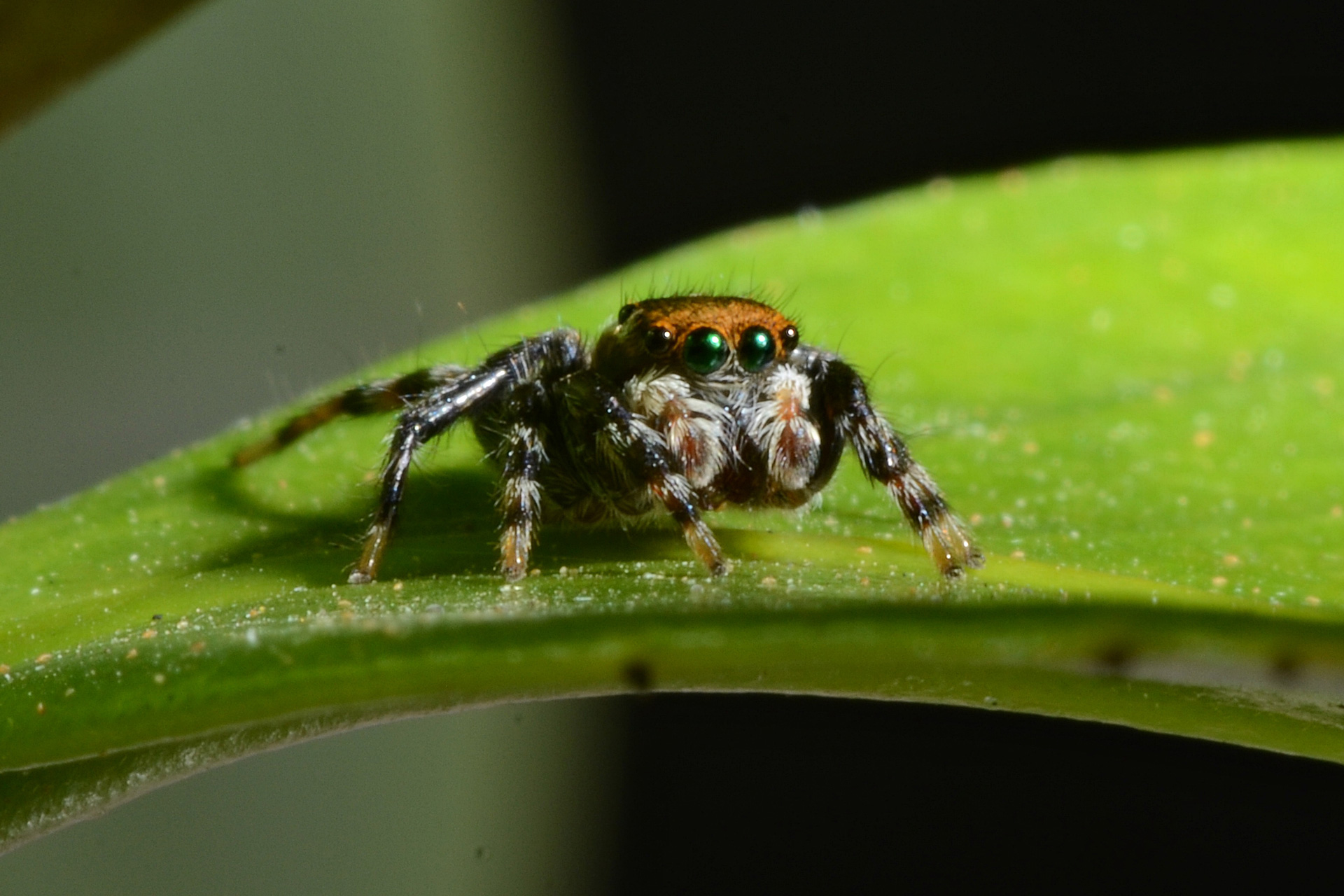October is a great month for spiders. All across Canterbury, as the weather warms, people will be rejoicing over the greater ease in drying their laundry, but they may also notice something else. More and more, spiders will be making an appearance around homes throughout New Zealand. Even here in the US, where I’m currently visiting, people are now talking about the end of Summer, but this month is a great time for spiders in another way. I have never seen so many spider-themed Halloween decorations in all my life; it is an arachnologist’s dream to see spiders get celebrated.
An increase in spider numbers may be perplexing for some but having more spiders around us is, in fact, a good thing. Insects also increase in number during the warmer months and, without spiders, our world would be over-ridden with insects. Spiders are great at controlling a number of pests that lurk around our homes. We should do what we can to help them do their jobs.
Jumping Spiders
Of the spiders we encounter, jumping spiders may be some of the easiest for us to relate to. This is the largest family of spiders (with over 6,000 described species) and they are found throughout most parts of the world, including Mount Everest. Most jumping spiders don’t build webs for prey capture, but instead they actively hunt for their prey. They have remarkably good eyesight for animals of their size which they use to help locate their next meal. And, while they may be formidable predators, they are harmless to us. In fact, their two big eyes (called the ‘principal eyes’, along with their six smaller eyes called the ‘secondary eyes’) may help these spiders appear attractive to some people. Perhaps even cute.
Some jumping spiders, like the peacock spiders in Australia, are even known for their dazzling array of colour, which can also help them to appear cute. Then there are other species that are not so colourful, being mainly brown, but I would argue that they are cute as well. Despite their appearance, though, there is a good way to tell that you’ve found a jumping spider, wherever you are in the world. All you have to do is look at a spider. If the spider turns and looks back at you with its two big eyes at the front, you will know that the spider you have found is, indeed, a jumping spider.
House hoppers

The first jumping spider I was introduced to is commonly known in New Zealand as the house hopper, but it has had numerous scientific name changes in all the years I’ve known them – Euophrys parvula, Trite parvula, Hypoblemum albovittatum and, currently, Hypoblemum griseum. To simplify things, I sometimes just call them by my own nickname, Bob. These little brown spiders are often found walking on the outside walls of our homes in Christchurch and in many other places around New Zealand. Like many jumping spiders, they build cocoon-like nests out of silk which they use for egg laying and as retreats, and this species often builds nests in the nooks and crannies around our homes.

Helpis minitabunda
Another spider found around homes in New Zealand is Helpis minitabunda. This species has been more common in the North Island, but there are increasing reports from iNaturalist of them being found in Christchurch as well. These spiders were introduced from Australia and they were first seen in Auckland in 1972. The male looks quite different from the female, being darker in colour, but both can be readily identified because they are larger slender spiders with long legs.

Helpis male 
Helpis female
Trite planiceps
If we look more closely in our gardens we may find other species still. One example is Trite planiceps, a New Zealand species. This is New Zealand’s largest species of jumping spider and it is commonly found in the rolled-up leaves of flax bushes. You can see me looking for this spider at Spencer Park in this video, which aired on the children’s TV show Fanimals in June 2019.

Trite auricoma
A close cousin of Trite planiceps is another New Zealand species, Trite auricoma. In Latin, “auricoma” means “golden hair”, and this species is commonly known as the golden-brown jumping spider. It can also be found in flax and other foliage, but I have seen them around houses as well.

It’s Arachtober!
This is just a handful of the many interesting spiders found in New Zealand. And, while spiders are typically celebrated in October for Halloween, you can also see them being celebrated during this month for another reason. To many arachnologists, October is otherwise known affectionately as ‘Arachtober’, a tradition which began in 2007 on Flickr and then spread rapidly across numerous social media platforms all around the world. During this month of the year, many spider photos will be shared online using the hashtag #Arachtober. If you want to learn more about spiders, and if you use social media, I do encourage you to follow along. You may find yourself with a greater appreciation for spiders, and perhaps even find yourself with a new eight-legged friend.
—
Dr Fiona Cross (“Doctor Spider”) is an arachnologist who began her studies in Psychology (BSc (Hons)) before moving to the School of Biological Sciences | Te Kura Pūtaiao Koiora at the University of Canterbury for her MSc, PhD and postdoctoral work. She is an expert on spider cognition and has been going to Kenya to work with jumping spiders since 2006.
Follow Fiona on Twitter, Instagram and Facebook to keep up to date with her latest research news and spider photos. She also has a personal website dedicated to her work.
All photos © Dr Fiona Cross.




























